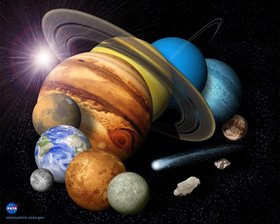
Jupiter
Seen low in the western sky after sunset, Jupiter is shining at magnitude -1.9 at the start of the month and has an angular diameter of 34.3 arc seconds. By month's end, these have reduced slightly to -1.7 magnitudes and 32.1 arc seconds. One hour after sunset it will be about 30 degrees above the horizon. Jupiter passes half a degree below the 4th magnitude star, Sigma Leonis on July 12th and continues to move eastwards, moving towards the Leo-Virgo boarder. Due to the low elevation, the atmosphere will limit our view somewhat but up to four of the Gallilean moons will be visible as well as the dark equatorial bands. The Great Red Spot will be harder to spot unless the seeing and transparency of the atmosphere are good.
Saturn
Having been in opposition on June 3rd, lies some 6 degrees north of Antares (in Scorpius) in southern Ophiuchus. It continues its retrograde motion westwards across the sky throughout July, narrowing its gap between Mars (now moving eastwards) from 19 degrees to 11 degrees as the month progresses. At the same time the brightness drops a little, from magnitude +0.1 to magnitude +0.3 whilst its apparent diameter falls from 18.2 to 17.6 arc seconds. Though only at an elevation of 20 degrees when due south at around 11 pm as July begins (and 9pm at month's end) the beautiful ring system, now at an inclination of 26 degrees is still worth observing as is Saturn's brightest Moon, Titan.
Mercury
Mercury passes behind the Sun (Superior Conjunction) on July 6th, but may become visible in binoculars about mid month when it sets about 45 minutes after sunset as it lies just half a degree above Venus. During July's final week it will be seen to the upper left of Venus and moves closer to Regulus, in Leo, until the two close to just 22 arc minutes on the evening of July 30th.
Mars
Mars (close to Saturn) can be seen in the south-southwest after sunset above and to the right of Antares and the fan of Scorpius. It halted its westwards (retrograde) motion in Libra on June 30th so, during July will be moving eastwards into Scorpius and ending the month some 10 degrees to the west of Antares. As we move further away, Mars fades from magnitude -1.4 to -0.8 whilst its disk shrinks from 16 to 13 arc seconds. Mars is due south - and so highest in the sky - at ~9:30 BST on th first of July, and even though its elevation is only then about 19 degrees, a medium sized telescope may still be able to see (or image) details on the surface such as the polar caps and Syrtis Major. [I imaged Mars using a webcam when still having an angular diameter of 18 arc seconds. Visually, I could barely make out any details but was surprised how much became visible having processed 1,000 frame video sequences taken through red, green and blue filters.]
Venus
Venus, having passed behind the Sun on June 6th becomes visible in mid month low in the west-northwest shining at magnitude -3.9 in Gemini. It passes to the lower left of Pollux on the 13th andpasse through the Beehive Cluster, M44,in Cancer on the 20th, ending the month 5 degrees to the west of Regulus in Leo.
The Planets in July

